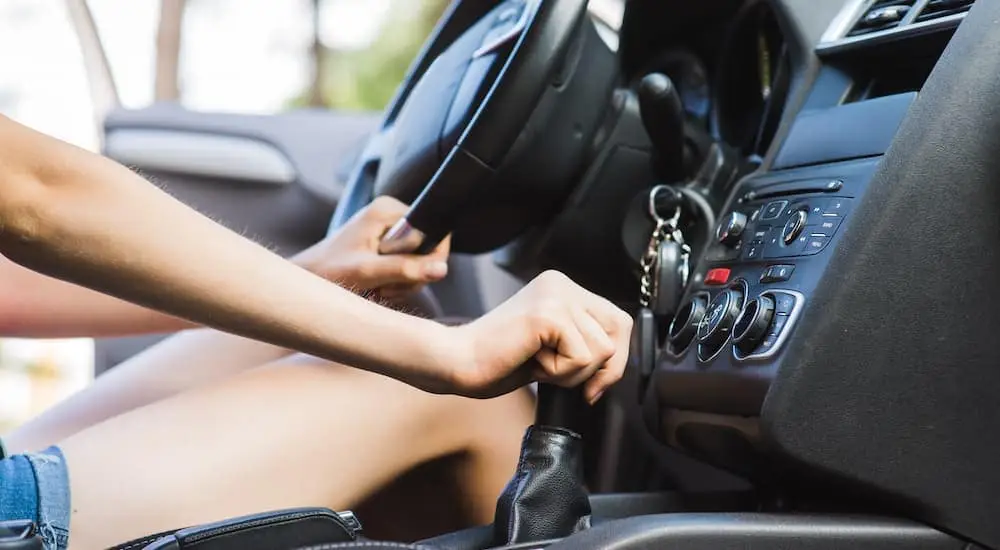Learning how to drive a manual car might seem tricky at first, but it’s not as hard as you think. A manual car is different from an automatic because you have to change gears yourself while driving. This involves using three pedals: the clutch, brake, and accelerator. If you’re completely new to this, don’t worry—this guide will break it all down into simple steps that anyone can follow.
First, let’s think of the car as a bicycle. You know how you change gears on a bike when going uphill or downhill? It’s the same idea in a manual car, except you use a gear stick and clutch to do it. The clutch is like a switch between the engine and the wheels. When you press the clutch, it disconnects the engine, letting you safely change gears without damaging anything.
Here’s the good news: once you understand the basic steps—pressing the clutch, shifting gears, and balancing it with the accelerator you’re halfway there! Driving a manual car is all about timing and coordination, which gets easier with practice.
What Is a Manual Transmission?
A manual transmission, also called a stick shift, requires the driver to manually change gears using a clutch pedal and gear lever. Unlike automatic cars, where gear changes happen seamlessly, driving a manual gives you direct control over the engine’s power and performance. It’s a skill that brings a sense of mastery and opens the door to driving vehicles that offer unmatched driving pleasure.
Why Learn to Drive a Manual Car?
There are plenty of reasons to learn how to drive a manual car. For one, it enhances your driving skills and makes you adaptable to various vehicles. Many sports cars, trucks, and older vehicles are manual, so knowing how to drive one broadens your options. Plus, manual cars tend to be more fuel-efficient and often cheaper to maintain.
Learning this skill can also help in emergency situations where only a manual car is available. And let’s face it, there’s a certain cool factor in confidently handling a stick shift!
Getting Familiar with the Manual Car Components
Before hitting the road, you need to understand the essential components of a manual car:
- Clutch Pedal: Located on the far left, the clutch disconnects the engine from the wheels, allowing you to shift gears.
- Brake Pedal: Found in the middle, it slows or stops the car.
- Accelerator Pedal: On the far right, it controls the car’s speed.
- Gear Shifter: Typically located between the front seats, the gear shifter allows you to choose different gears.
- Handbrake: Used to keep the car stationary when parked or to assist with hill starts.
Take some time to familiarize yourself with these components. Sit in the driver’s seat and practice pressing the pedals and moving the gear lever while the car is off. Understanding their placement will make you feel more confident when you start driving.
How does the Clutch Works?
The clutch is the heart of manual driving. It works by disconnecting the engine from the wheels when pressed, allowing you to change gears smoothly. Mastering clutch control is the key to driving a manual car like a pro. This might feel tricky at first, but with practice, it becomes second nature.
When the clutch is fully pressed, the engine and transmission are disengaged. As you slowly release it, they reconnect. This transition is what you’ll learn to manage for smooth starts and gear shifts.
Step-by-Step Guide to become a Manual Car Pro Driver
Let’s break down the process of driving manual car and becoming a professional at it.
Starting the Car
- Press the clutch pedal all the way to the floor.
- Place the gear shifter in neutral (you can wiggle it left and right to confirm it’s in neutral).
- Turn the ignition key or press the start button to start the engine.
- Keep your foot on the clutch until you’re ready to move.
Moving the Car
- Press the clutch pedal fully and move the gear shifter to first gear.
- Slowly release the clutch while gently pressing the accelerator pedal. Pay attention to the “biting point” — the moment the car begins to move.
- Keep a steady pressure on the accelerator and fully release the clutch as the car gains momentum.
Shifting Gears
- Accelerate until you feel the engine revs increase (listen to the sound or check the tachometer for guidance).
- Press the clutch pedal and move the gear shifter to the next gear (e.g., second gear).
- Gradually release the clutch while applying light pressure to the accelerator.
Stopping the Car
- Press the clutch pedal fully and move the gear shifter to neutral.
- Apply the brake gently to bring the car to a complete stop.
- Once stopped, you can release the clutch.
Reversing the Car
- Press the clutch pedal and move the gear shifter into reverse.
- Slowly release the clutch while pressing the accelerator lightly to move backward.
Tips to Master Hill Starts In Manual Car when Driving
Starting on a hill is one of the most challenging parts of driving a manual car. Use the handbrake to prevent rolling back. Here’s how to do it:
- Pull the handbrake up while you’re stationary on the hill.
- Press the clutch pedal and shift into first gear.
- Slowly release the clutch to the biting point and press the accelerator lightly.
- Release the handbrake as the car begins to move forward.
Common Mistakes to Avoid when Driving Manual Cars
Learning to drive a manual car involves a learning curve, and mistakes are part of the process. Here are some common mistakes and how to avoid them:
- Stalling the Engine: This happens when you release the clutch too quickly or don’t press the accelerator enough. Don’t panic—simply restart the car and try again.
- Riding the Clutch: Keeping your foot on the clutch pedal unnecessarily can wear it out. Only use it when shifting gears.
- Shifting Gears Too Soon or Too Late: Learn to recognize the right time to shift by listening to the engine or watching the tachometer.
Building Manual Vehicle Driving Confidence with Practice
Practice is the secret to becoming a pro manual driver. Start in an empty parking lot or quiet road where you can focus without distractions. Spend time perfecting clutch control, shifting gears, and starting on inclines. As you gain confidence, transition to busier roads and different driving conditions.
Benefits of Driving a Manual Car
There’s a unique satisfaction in mastering a manual car. It connects you to the driving experience in a way automatic cars can’t. You’ll develop better control over your vehicle, improve your reaction times, and enhance your overall driving skills. Plus, you’ll appreciate the versatility of being able to drive any car.
When Should You Use Each Gear?
Understanding gear usage is essential for smooth driving. Here’s a quick guide:
- First Gear: Starting the car or driving at very slow speeds.
- Second Gear: Gaining momentum or driving through tight corners.
- Third to Fifth Gears: Cruising at moderate to high speeds.
Staying Calm During Mistakes
It’s natural to feel nervous or frustrated when things don’t go as planned. Whether it’s stalling at a traffic light or struggling with hill starts, don’t let these moments discourage you. Every mistake is a chance to learn and improve. The more you practice, the smoother your driving will become.
Tips for Long-Term Success
- Practice regularly to reinforce your skills.
- Pay attention to the road and anticipate gear changes in advance.
- Stay patient with yourself as you learn—it’s a journey, not a race.
- Keep your car in good condition by checking the clutch and transmission system periodically.
Why Manual Driving Is Worth It
Learning to drive a manual car is more than a practical skill; it’s a gateway to a deeper understanding of how vehicles work. Whether you’re navigating steep hills, enjoying the thrill of a sports car, or simply savoring the sense of accomplishment, the rewards are immense. You’ll gain confidence, adaptability, and a newfound appreciation for the art of driving.
Conclusion
Mastering a manual car takes time, effort, and plenty of practice, but the payoff is well worth it. By understanding the basics, staying consistent, and embracing the challenges, you’ll soon find yourself driving with ease and confidence. So, get behind the wheel, take it one step at a time, and enjoy the journey to becoming a pro manual driver.

